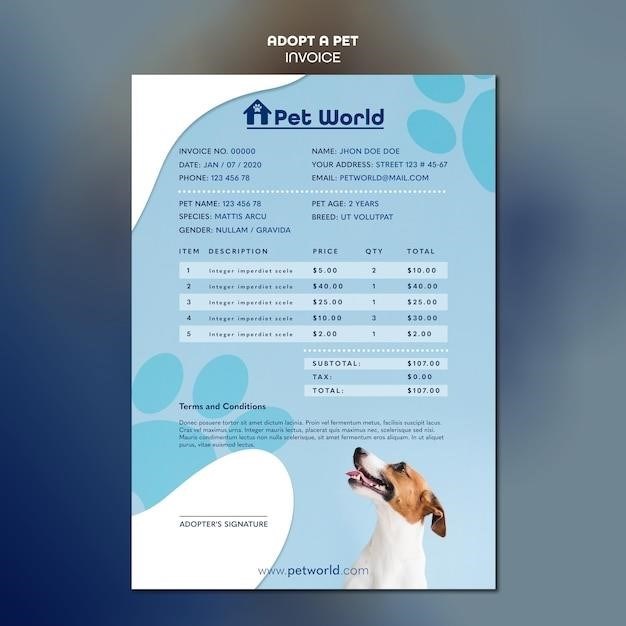Paracetamol Dosage for Dogs⁚ A Comprehensive Guide
This comprehensive guide provides essential information about using paracetamol for dogs, covering dosage, safety considerations, potential side effects, and crucial factors to consider before administering this medication. It explores why relying on a generic “paracetamol dogs dosage chart pdf” can be dangerous and emphasizes the importance of consulting a veterinarian for personalized advice.
Understanding Paracetamol and its Use in Dogs
Paracetamol, also known as acetaminophen, is a common over-the-counter pain reliever for humans; While it can effectively treat fever and pain in dogs, it’s crucial to understand that paracetamol is toxic to cats and should never be given to them. The use of paracetamol in dogs is generally restricted to specific situations and should always be prescribed by a veterinarian.
Veterinarians might prescribe paracetamol for dogs, especially in cases of acute pain, such as that caused by trauma. It’s important to note that while some online resources might offer “paracetamol dogs dosage chart pdf” downloads, these should be avoided. These charts are not a substitute for professional veterinary advice and could lead to accidental overdose or other complications.
Paracetamol Dosage for Dogs⁚ A Breakdown
The typical dosage of paracetamol for dogs is 10 to 15 mg per kilogram of body weight. This dosage should be administered once a day and only for a short period, usually one or two days, unless otherwise directed by your veterinarian. It’s essential to understand that these are general guidelines, and the actual dosage may vary based on factors like your dog’s age, health condition, and the severity of their pain.
Paracetamol for dogs is often available in a veterinary-specific formulation, such as Pardale V. This ensures the correct formulation and dosage for dogs, minimizing the risk of accidental overdose. Never administer human paracetamol to dogs without consulting a veterinarian, as the formulation and dosage can be significantly different, leading to potential toxicity.
Factors Affecting Paracetamol Dosage
Several factors can influence the appropriate paracetamol dosage for your dog, making a generic “paracetamol dogs dosage chart pdf” unreliable. Your veterinarian will consider these factors when determining the right dosage for your pet⁚
- Dog’s Weight⁚ Dosage is typically calculated based on your dog’s weight, ensuring they receive the appropriate amount of medication.
- Age⁚ Puppies and senior dogs may require different dosages than adult dogs due to their unique metabolic needs.
- Health Condition⁚ Underlying health conditions, such as liver or kidney disease, can affect how your dog processes medication, requiring adjustments to the dosage.
- Severity of Pain⁚ The intensity of your dog’s pain will influence the frequency and duration of paracetamol administration.
- Drug Interactions⁚ If your dog is already taking other medications, your veterinarian will need to consider potential interactions with paracetamol.
Never attempt to determine the dosage yourself; always consult with your veterinarian for personalized advice based on your dog’s specific needs.
Common Side Effects of Paracetamol in Dogs
While paracetamol can effectively manage pain in dogs, it’s essential to be aware of potential side effects. These side effects are generally mild but can become serious if left untreated. Common side effects include⁚
- Gastrointestinal Issues⁚ Dogs may experience vomiting, diarrhea, or loss of appetite after taking paracetamol.
- Liver Problems⁚ Paracetamol can be toxic to the liver, especially in high doses or prolonged use. Signs of liver damage include lethargy, jaundice, and abdominal pain.
- Kidney Issues⁚ In some cases, paracetamol can negatively affect kidney function, leading to decreased urine output or changes in urine color.
- Blood Disorders⁚ Rarely, paracetamol can cause red blood cell abnormalities, leading to anemia.
If you notice any of these side effects in your dog, it’s crucial to contact your veterinarian immediately. They can assess the situation and recommend appropriate treatment.
Paracetamol Toxicity in Dogs
Paracetamol toxicity in dogs is a serious concern. It occurs when a dog ingests a large amount of paracetamol, exceeding the safe dosage. This can lead to severe health complications and even death. The toxic dose varies depending on the dog’s size and weight, but even a small amount can be dangerous for smaller dogs. Symptoms of paracetamol toxicity can appear within a few hours of ingestion and include⁚
- Loss of appetite
- Vomiting
- Diarrhea
- Lethargy
- Abdominal pain
- Difficulty breathing
- Yellowing of the eyes or gums (jaundice)
If you suspect your dog has ingested paracetamol, immediate veterinary attention is crucial. Prompt treatment can significantly improve the chances of survival and minimize long-term health effects. Never attempt to induce vomiting or administer any medication without consulting your veterinarian.
Preventing Paracetamol Poisoning in Dogs
Preventing paracetamol poisoning in dogs is crucial for their safety. Here are some essential measures to take⁚
- Store all medications, including paracetamol, out of reach of your dog. Keep them in a secure cabinet or locked container.
- Never give your dog human paracetamol without a veterinarian’s prescription. Even a small amount can be toxic.
- Be cautious with medications left on countertops or tables. Dogs can easily access these areas.
- Educate children about the dangers of giving medication to pets. They should be taught to never give their dog any medication without adult supervision.
- Dispose of unused or expired medication properly. Follow your local guidelines for safe disposal.
- Be aware of the signs of paracetamol toxicity. If you suspect your dog has ingested paracetamol, seek immediate veterinary attention.
By implementing these precautions, you can significantly reduce the risk of your dog experiencing paracetamol poisoning.
Alternatives to Paracetamol for Dog Pain Relief
While paracetamol can be effective for some dogs, it’s important to remember that it’s not always the safest or most appropriate option. Many other pain relief medications are available for dogs, and your veterinarian can help you choose the best one for your pet’s specific needs. Here are some common alternatives to paracetamol⁚
- Nonsteroidal Anti-Inflammatory Drugs (NSAIDs)⁚ These drugs, such as carprofen, meloxicam, and robenacoxib, are often used to manage pain and inflammation in dogs. Your veterinarian will determine the appropriate dosage and duration of treatment.
- Opioids⁚ Opioids like tramadol can be effective for moderate to severe pain. They are typically used for short periods due to the potential for side effects.
- Gabapentin⁚ This medication is often prescribed for nerve pain and can also help manage pain associated with arthritis.
- Other Treatments⁚ In addition to medication, other pain relief options include physical therapy, acupuncture, and laser therapy. These may be beneficial for certain conditions.
It’s crucial to work closely with your veterinarian to determine the best pain relief approach for your dog. They will consider the underlying cause of pain, your dog’s overall health, and potential risks and benefits of different medications.
When to Consult a Veterinarian
While the internet offers a wealth of information, it’s crucial to remember that self-treating your dog with any medication, including paracetamol, can be dangerous. A veterinarian is the only qualified professional who can accurately diagnose your dog’s condition and determine the appropriate course of treatment. Here are some situations where seeking immediate veterinary care is vital⁚
- If your dog has ingested paracetamol or any other medication that wasn’t prescribed by your veterinarian⁚ Prompt action is crucial to prevent potential toxicity.
- If your dog is exhibiting any signs of illness or pain, such as lethargy, vomiting, diarrhea, loss of appetite, or difficulty breathing⁚ These could indicate a serious health problem requiring professional attention.
- If you’re unsure about the correct dosage of any medication for your dog⁚ Always consult your veterinarian for personalized dosage recommendations.
- If you’re concerned about the potential side effects of paracetamol or any other medication⁚ Your veterinarian can address your concerns and advise you on the safest course of action.
Remember, your dog’s health is a top priority. Don’t hesitate to seek veterinary care if you have any concerns about your pet’s well-being.
Paracetamol, a common pain reliever for humans, can be a valuable tool for managing pain in dogs when used appropriately and under veterinary supervision. However, it’s crucial to understand that paracetamol can be toxic to dogs, and administering it without professional guidance can have serious consequences. Relying solely on “paracetamol dogs dosage chart pdf” found online is highly risky and can lead to accidental overdosing.
The information provided in this guide serves as a starting point for understanding the potential risks and benefits of paracetamol for dogs. However, it’s crucial to remember that every dog is different, and what works for one may not be suitable for another. Always consult a veterinarian for personalized advice regarding your dog’s specific needs and health condition. By prioritizing professional guidance and responsible medication practices, you can ensure the best possible care for your beloved canine companion.

Disclaimer
The information presented in this guide is intended for general knowledge and informational purposes only, and should not be considered as a substitute for professional veterinary advice. This guide does not provide medical advice, and it is essential to consult with a qualified veterinarian for any health concerns or before administering any medication to your dog.
The information provided in this guide, including any reference to “paracetamol dogs dosage chart pdf”, should not be interpreted as a recommendation or endorsement of any specific medication or treatment. The use of paracetamol in dogs should always be under the guidance of a qualified veterinarian. This guide does not constitute a substitute for professional veterinary care, and it is crucial to seek professional advice for any health concerns or before making any decisions regarding your dog’s health or treatment.
